MARIANI’SVirtual
Gourmet
May 19,
2013
NEWSLETTER
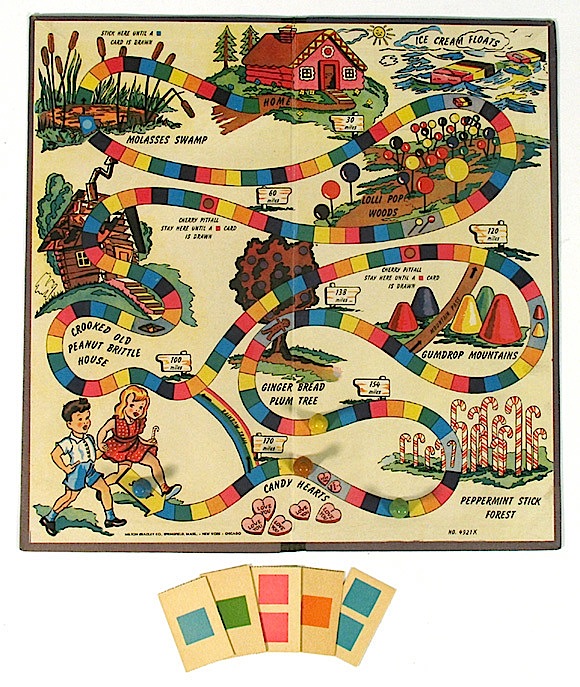
❖❖❖
THIS WEEK
DRIVING THE
PACIFIC COASTLINE
PART
ONE
by Christopher Mariani
NEW YORK CORNER
Carbone
by
John Mariani
NOTES FROM THE WINE
CELLAR
Spanish Reds
by John Mariani
❖❖❖

by Christopher Mariani
With only eight days
to see as much of the California coast as possible,
I
decided to fly into San Diego and drive north on
Highway 1, stopping in cities
like La Jolla, Santa Barbara, Carmel, Napa Valley and San Francisco. I dined at many
terrific restaurants; some
new, some old. Here’s where we went.
Day one: San Diego
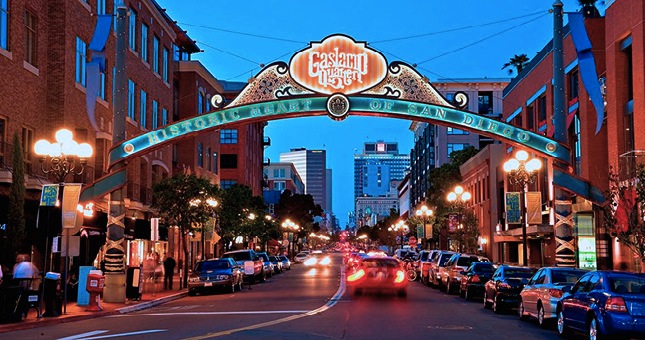 After
touching down in SD, we took a short drive through the
city and
checked into the pet-friendly Hotel
Solamar, located in the city’s bustling
downtown Gaslamp Quarter (left), just a few blocks from
Seaport Village and the sunny
boardwalk. After settling into our room, we ventured
out onto Sixth Avenue and
toured the vibrant neighborhood, lined with storefront
after storefront of
casual seafood inspired restaurants, outdoor burger
joints, loads of pubs,
specialty food markets and Italian cafes, serving
creamy gelato and strong
espressos.
After
touching down in SD, we took a short drive through the
city and
checked into the pet-friendly Hotel
Solamar, located in the city’s bustling
downtown Gaslamp Quarter (left), just a few blocks from
Seaport Village and the sunny
boardwalk. After settling into our room, we ventured
out onto Sixth Avenue and
toured the vibrant neighborhood, lined with storefront
after storefront of
casual seafood inspired restaurants, outdoor burger
joints, loads of pubs,
specialty food markets and Italian cafes, serving
creamy gelato and strong
espressos.
For
lunch, we stopped by the highly recommended Zanzibar
Café on G Street (below), a casual
yet sophisticated restaurant with a truly relaxed
California vibe. The front
doors and windows swung wide open as a gentle, warm
California breeze 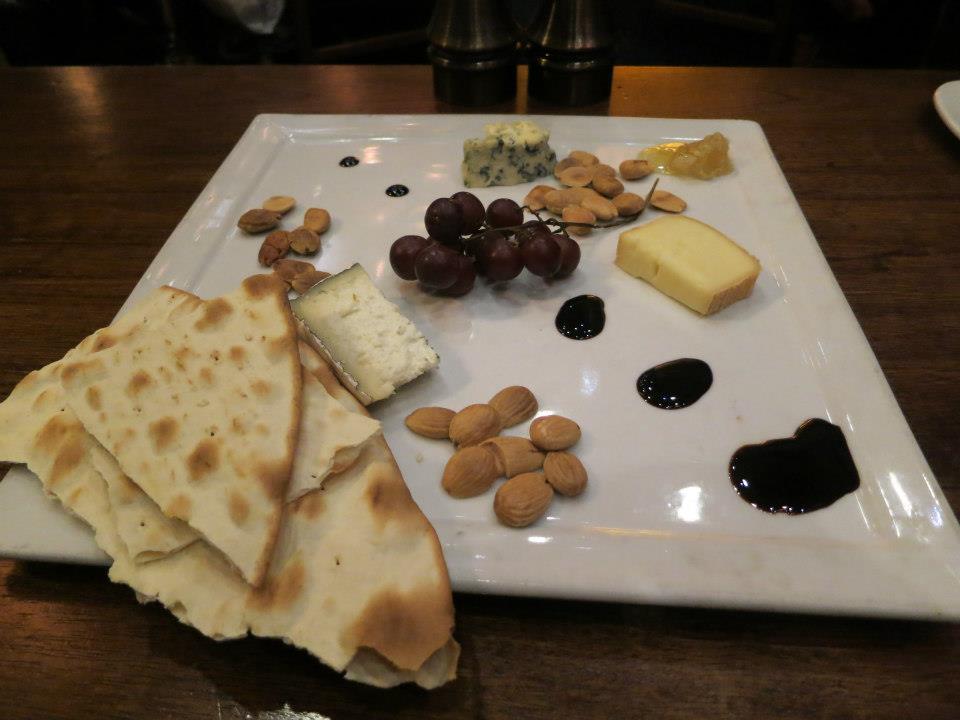 waltzed
through the dining room, brushing by young couples
sipping tall glasses of
white wine and ice cold local beer. We began with a
simple tuna tartare, mixed
with sliced avocado and daikon sprouts, accompanied by
California’s hoppy
“racer 5 IPA.” Next, a pressed turkey and bacon melt
on warm sourdough,
oozing with pepper jack cheese and avocado, along with
a mixed salad, complemented
with local fresh vegetables and cheeses. Back outside,
we strolled leisurely to
the boardwalk for a walk along the port, lined with
small and large white boats
of every description, motor and sail, while we inhaled the ocean’s salty
air.
waltzed
through the dining room, brushing by young couples
sipping tall glasses of
white wine and ice cold local beer. We began with a
simple tuna tartare, mixed
with sliced avocado and daikon sprouts, accompanied by
California’s hoppy
“racer 5 IPA.” Next, a pressed turkey and bacon melt
on warm sourdough,
oozing with pepper jack cheese and avocado, along with
a mixed salad, complemented
with local fresh vegetables and cheeses. Back outside,
we strolled leisurely to
the boardwalk for a walk along the port, lined with
small and large white boats
of every description, motor and sail, while we inhaled the ocean’s salty
air.
That
evening, after a late afternoon snooze in one of Hotel
Solamar’s comfy beds, we
dressed and made our way down to their spacious
restaurant, Jsix. High
ceilings, an attractive modern design and a grand bar
make up this chic Kimpton
Hotels restaurant. Years
ago
Kimpton set a distinctly modern standard for casual
chic in California, wholly
evident at the Solamar (below), which takes every advantage
of sunlight, not least at its sparkling pool area with
its terrific view of the city skyline.
At Jsix we sat in a
wrap-around banquet that surrounded our large, dark
wood table. Immediately, we
were approached by a scruffy waiter with long,
blondish hair who, from the
moment he opened his mouth, exuded a passion for the
restaurant, its chef, food
and wine selection. His affection for the menu’s
offerings made our decision
for dinner quite simple: “Surprise us with your
favorites!” And
so he did. The meal began with a
beautifully presented artisanal cheese board (above) with local
honeys. 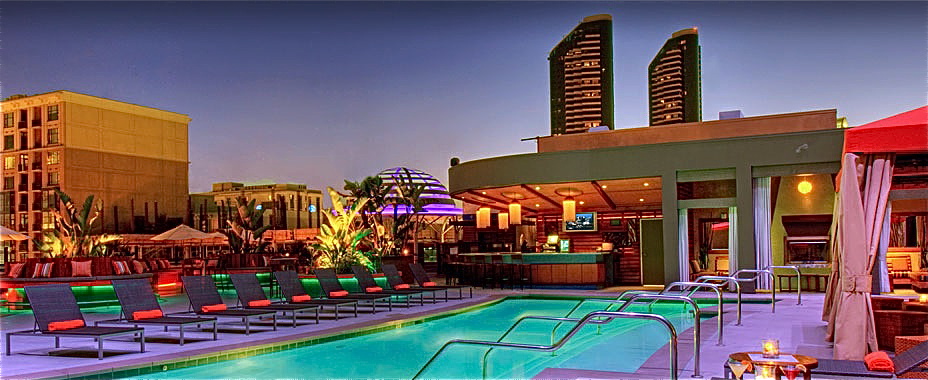 Next, chef
Christian Grave’s play on a kid’s favorite, “fried
bologna and gnocchi,” came
as pan-seared mortadella, with parmesan cheese and
crispy leeks. For the main
course, we enjoyed tender red wine-braised short ribs
served with garlicky
Swiss chard and crispy parsnip chips. Also,
caramelized Maine scallops with duck
fat fried potatoes and a porcini-chestnut
puree.
Desserts included caramel chocolate pie and a berry
mouse cake. The
night ended pleasantly, our stomachs full, and the
remaining two glasses of our
pinot noir before making our way back up to the room
made for an extra good
night’s sleep.
Next, chef
Christian Grave’s play on a kid’s favorite, “fried
bologna and gnocchi,” came
as pan-seared mortadella, with parmesan cheese and
crispy leeks. For the main
course, we enjoyed tender red wine-braised short ribs
served with garlicky
Swiss chard and crispy parsnip chips. Also,
caramelized Maine scallops with duck
fat fried potatoes and a porcini-chestnut
puree.
Desserts included caramel chocolate pie and a berry
mouse cake. The
night ended pleasantly, our stomachs full, and the
remaining two glasses of our
pinot noir before making our way back up to the room
made for an extra good
night’s sleep.
Day 2: La Jolla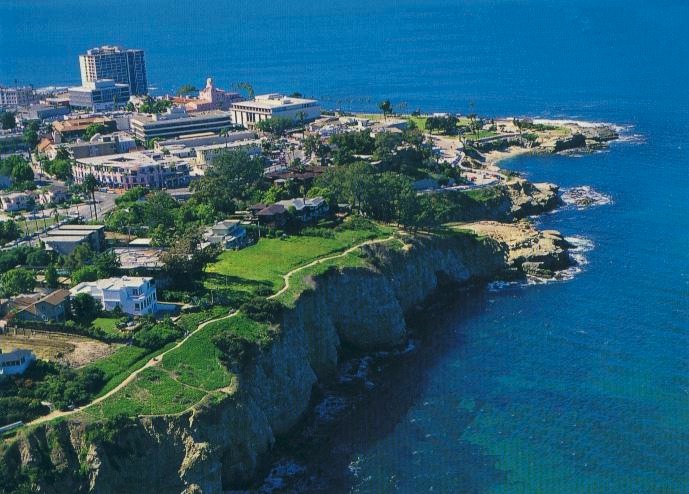
The
following morning, we woke up early, jumped in our
rented Ford Mustang
convertible and headed for the posh city of La Jolla,
a weekend destination for
San Diego’s super rich. If you are into exotic cars,
take a walk along Prospect
Place and prepare to be awed by the international
models arrayed along it. The
city is packed with luxury brand jewelry shops,
expensive art galleries,
including Peter Lik, and outdoor restaurants
overlooking the water. Venturing
off the main drag will bring you to Scripps Park,
where you can watch the silly
seals sunbathe for hours (above) on massive rock formations
that hover above the water.
Hundreds of seals lounge lazily about as spectators
snap pictures and soak up
some sun themselves.
After
a walk along the beach, we headed back into town and
stumbled upon a casual
hangout called José’s for lunch. Over a platter
of tortillas, crunchy tacos,
chimichangas, guacamole, corn chips and a pitcher of
refreshing sangria, we ate
slowly, enjoying the bliss of this gorgeous afternoon.
That
evening, we unknowingly checked into another Kimpton
hotel, Hotel
La Jolla,
located just outside of town. Upon entry, the lobby is
extremely modern and
artsy, filled with different textures, multiple hues
of beige,
unorthodox furniture and floor-to-
ceiling windows overlooking a trendy outdoor patio
dressed with fire pits and
lounge chairs. Our room was surrounded by two
balconies that afforded us a
stunning spectacle of the sun set around five o’clock.
We settled in and
changed into our evening wear for dinner at the
hotel’s swank restaurant, 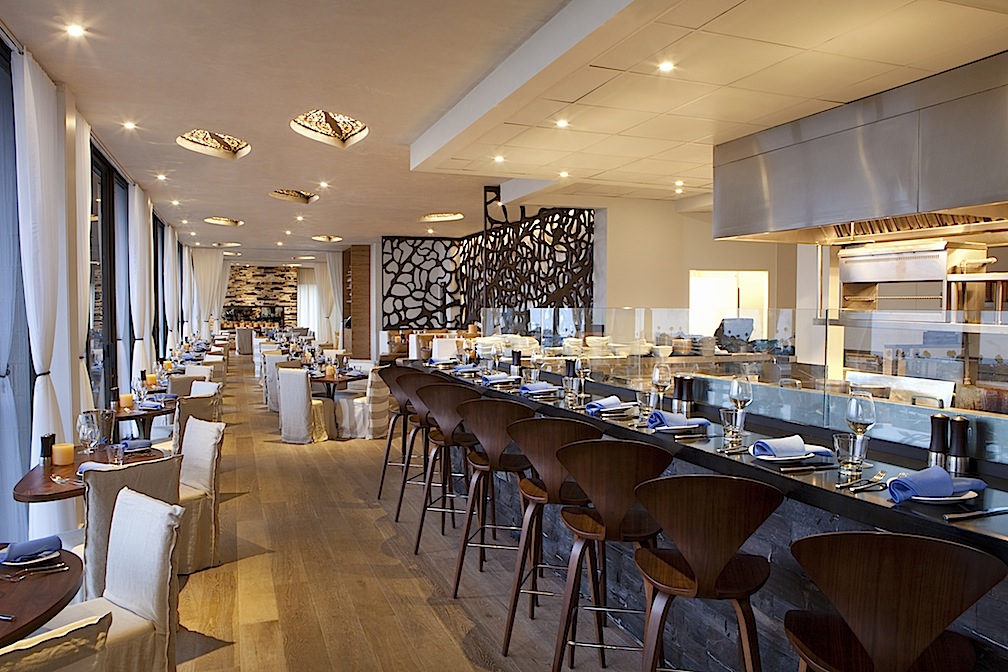 Cusp (left),
placed on the top floor, with an outstanding food and
beverage program, driven by executive chef Donald
Lockhart.
Cusp (left),
placed on the top floor, with an outstanding food and
beverage program, driven by executive chef Donald
Lockhart.
The room is draped with white
linens in crisp lines that draw the eye
towards the windows, looking out onto downtown La
Jolla. Our feast began with
toasted quinoa, raw yellowtail, a curry cream and
thick pita chips, a
reflection of Lockhart’s time spent cooking in Egypt.
Dungeness crab was laid
on a crisp flatbread with charred seasonal chiles,
roasted tomatoes and a lemon
vinaigrette. Next, crispy, fatty, delicious pork belly
coated with a honey
Sriracha glaze and grilled Tuscan kale dressed with
black garlic dressing and grano padano
cheese. For pastas, casarecce was
mixed with tender lamb
meatballs, roasted tomatoes and a light curry cream
sauce. Entrees included a
Moroccan-style salmon and a bone-in, well-marbled
ribeye cut of prime beef.
Cusp’s desserts are truly impressive; especially the
warm crispy apple fritter
that looks like a donut, drizzled with caramel sauce
and vanilla gelato.
Also worth noting is Cusp’s
cocktail program. They take their drinks seriously in
California.
The
next morning, we woke up early, jumped into the
convertible and headed
towards Santa Barbara.
Check out upcoming issues of the Virtual
Gourmet to see
where we ate and lodged along the way up north.
❖❖❖
HOTTEST RESTAURANT IN NEW YORK RIGHT NOW
by
John Mariani
Photos
by P.Lewis for Bloomberg
 They actually
pick up the phone at Carbone
and a very affable person tells you that they book
tables 30 days out. The food has gotten mixed
reviews thus far, but the stratospheric prices
have been causing sticker shock.
They actually
pick up the phone at Carbone
and a very affable person tells you that they book
tables 30 days out. The food has gotten mixed
reviews thus far, but the stratospheric prices
have been causing sticker shock.
Yet Carbone, on
the premises of an old Italian-American joint
named Rocco’s in Greenwich Village, is easily the
hottest restaurant of the moment in New York and
getting a rez is only slightly less difficult than
getting an audience with the new Pope, which says
a lot more about a kind of feeding frenzy driven
by two sectors: the food media that hyped
Carbone’s opening for months in advance and those
people who always need to be the first to say, “I
ate there already . . . and you didn’t.”
Private numbers and email
addresses are being passed around; secretaries
will be fired if they can’t snare a table for six
at eight on the ninth; IPhones snap fuzzy photos
tweeted on the spot. Bloggers boast, “u
GOTTA have the meat-a-balls,” and “veal parm is 50
freaking dollars but AWESOME!” And
this is
before the NY Times has even reviewed the
place.
Plenty of new places get their
three months’ of hype, but not since Keith McNally
opened Minetta Tavern around the corner from
Carbone has a restaurant been as eagerly awaited,
as if Tom Brady was coming to the Jets.
Carbone’s owners, Rich Torrisi,
Mario Carbone and Jeff Zalaznick (above) have
been the food media’s darlings since debuting
their tiny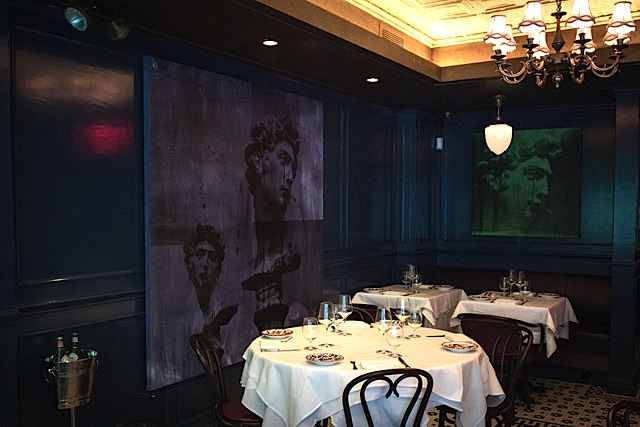 storefront Torrisi Italian Specialty Restaurant on
Mulberry Street, serving a 5-course meal for only
fifty bucks (at first). They refused to use
any imported products, not even prosciutto, and
the media proclaimed Torrisi’s a welcome antidote
to the high-priced Italian ristoranti
in the city like San
Pietro, SD26, and Marea.
Torrisi and Carbone then opened Parm, a little
shop selling veal parm for $25 and baked ziti for
$12. Once again the media raved that the food was
cheap and delicious—just the way Italian-American
food should
be! Not like those uptown truffle-oiled $26
pastas and $40 caviar-topped branzinos.
This, despite the fact that the same media have
largely ignored popular Italian-American
restaurants like Patsy’s
and Il Mulino
in Manhattan and a slew of others in Queens, the
Bronx and Brooklyn.
storefront Torrisi Italian Specialty Restaurant on
Mulberry Street, serving a 5-course meal for only
fifty bucks (at first). They refused to use
any imported products, not even prosciutto, and
the media proclaimed Torrisi’s a welcome antidote
to the high-priced Italian ristoranti
in the city like San
Pietro, SD26, and Marea.
Torrisi and Carbone then opened Parm, a little
shop selling veal parm for $25 and baked ziti for
$12. Once again the media raved that the food was
cheap and delicious—just the way Italian-American
food should
be! Not like those uptown truffle-oiled $26
pastas and $40 caviar-topped branzinos.
This, despite the fact that the same media have
largely ignored popular Italian-American
restaurants like Patsy’s
and Il Mulino
in Manhattan and a slew of others in Queens, the
Bronx and Brooklyn.
So why is Carbone getting such
attention? It’s certainly not the location or the
décor. The premises certainly didn’t cost
millions of dollars to renovate and Greenwich
Village rents are not (yet) as high as they are in
midtown. Carbone did not cost $20 million to build
like Lincoln
Ristorante at Lincoln Center. And
they’re not paying $22 an hour to union
dishwashers.
Yet Torrisi and Carbone, who once
championed good, inexpensive Italian food, are now
charging $50 for veal parm, $28 for
penne primavera and
$33 for chicken scarpariello—not to mention $87 and
up for lobster fra diavolo.
According
to Torrisi and Carbone, they really just wanted to
showcase and refine the old-fashioned,
out-of-fashion red sauce Italian-American
restaurants of the post-war period, where families
shared a cold antipasto plate, got a big plate of
spaghetti with meatballs and expected a side order
of spaghetti with the veal parm, watched the
waiter whip up zabaglione tableside, and finished
off with drip-pot espresso with a lemon peel and a
bottle of Sambuca on the side.
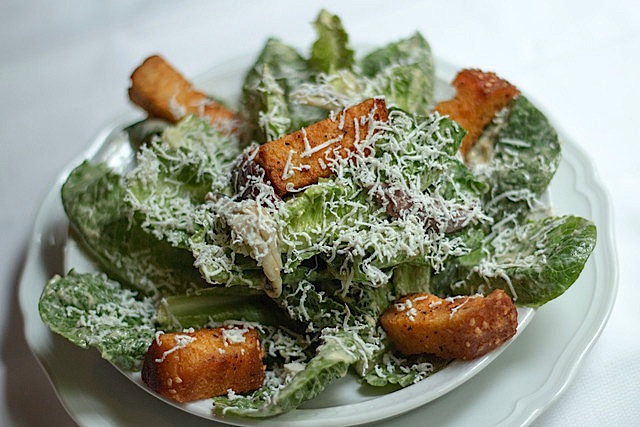 Torrisi and
Carbone want people to have fun. There’s a neon
name sign outside, superimposed on the still
visible Rocco's sign. Inside there are three
small, cramped, loud rooms, made to look like
stage sets. The waiters are outfitted in shiny
maroon Zak Pozen tuxedos and Adidas sneakers. The
rear room (supposedly the VIP section, made to
look like one where goombahs would meet) has no
windows, just brick walls, tables so close you
have to move them to get out. It’s a certain kind
of aesthetic that borrows equally from a nostalgia
for Little Italy eateries like Angelo’s
(where veal parmigiana sells for $24) and S.P.Q.R. (where
linguine with clam sauce goes for $18) and the
cool modernism of artwork curated by Vito
Schnabel. There are white tablecloths—three of
them--on each table. The menu is about three feet
wide. The huge wine list has very few red
bottlings under $95 and the corkage fee for BYOB
is $50 a bottle. They
play 1960s doo-wop. You get Sambuca at meal’s end.
Torrisi and
Carbone want people to have fun. There’s a neon
name sign outside, superimposed on the still
visible Rocco's sign. Inside there are three
small, cramped, loud rooms, made to look like
stage sets. The waiters are outfitted in shiny
maroon Zak Pozen tuxedos and Adidas sneakers. The
rear room (supposedly the VIP section, made to
look like one where goombahs would meet) has no
windows, just brick walls, tables so close you
have to move them to get out. It’s a certain kind
of aesthetic that borrows equally from a nostalgia
for Little Italy eateries like Angelo’s
(where veal parmigiana sells for $24) and S.P.Q.R. (where
linguine with clam sauce goes for $18) and the
cool modernism of artwork curated by Vito
Schnabel. There are white tablecloths—three of
them--on each table. The menu is about three feet
wide. The huge wine list has very few red
bottlings under $95 and the corkage fee for BYOB
is $50 a bottle. They
play 1960s doo-wop. You get Sambuca at meal’s end.
I ate at Carbone last week (my
editor at Esquire
snagged a 6:30 rez) and had a pretty swell time.
Everybody was cordial, the kitchen graciously sent
out some dishes to try, and the crowd seemed giddy
to be there.
There were tables of women dining together,
tables with raucous Wall Street guys in
shirtsleeves slugging back $400 bottles of Barolo
and a table of slouching Eastern Europeans with
Maria Sharapova wannabes. By 6:30 the place was
packed and it didn't let up when we got up to
leave nearly three hours later.
We had some excellent
langoustines in a “scampi” sauce, glorious
carpaccio, a first-rate Caesar salad (above), and
the $50 veal parm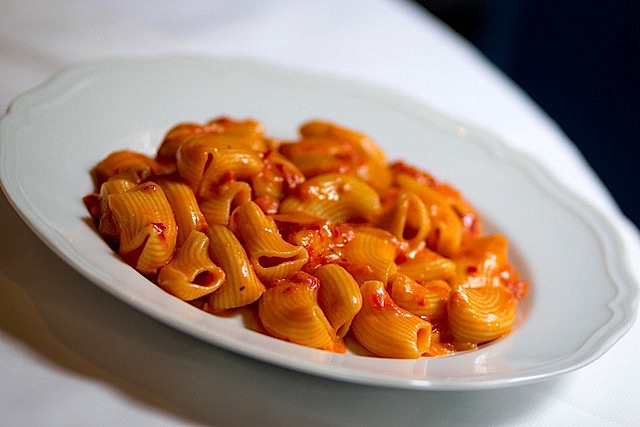 was terrific, though
not enough so to make me forget plenty of other
versions at half the price. Not
everything clicked: a nugget of Parmesan cheese
was served cold; salty, smoky Kentucky ham was
bewildering in an Italian-American restaurant; “Spicy
rigatoni vodka” (right)
was good but insanely rich; ravioli with chicken
livers Caruso swam in a pool of butter, and the
lobster fra diavolo (below), de-shelled and put back,
sat in a puddle of oily sauce.
was terrific, though
not enough so to make me forget plenty of other
versions at half the price. Not
everything clicked: a nugget of Parmesan cheese
was served cold; salty, smoky Kentucky ham was
bewildering in an Italian-American restaurant; “Spicy
rigatoni vodka” (right)
was good but insanely rich; ravioli with chicken
livers Caruso swam in a pool of butter, and the
lobster fra diavolo (below), de-shelled and put back,
sat in a puddle of oily sauce.
Was any of it transformative?
Does Carbone make a strong case that
Italian-American food should
cost as much as French haute cuisine? At this
point I’d say no, not because Torrisi and Carbone
aren’t using top-quality ingredients but because
for our bill of $543.41 for two people that night
(two cocktails, one bottle and one glass of wine,
plus an $80 tip), I should have been blown away by
food way better than any Italian restaurant’s in
New York.
In an online interview, Torrisi
and Carbone defended the now notorious $50 veal
parm insisting that they are using the finest
veal, buffalo mozzarella, and “tomatoes we canned
last summer,” and that “we’re not making tons of
money off this.”
But is there any question that their
high-end competitors use anything less than
the finest, most expensive ingredients? Of course
they do, yet SD26 sells a veal loin chop with cipolline,
asparagus, and smoked pancetta cream sauce for $37;
Armani Ristorante of Fifth Avenue sells a bone-in
veal cotoletta
alla
milanese with
arugula salad and Sicilian pachino
tomatoes for $44; a "Roman Style" veal piccata with
asparagus, capers, lemon, and potato puree at the
Maccionis’ new Sirio
Ristorante in the Pierre Hotel goes for $30;
and at Il Mulino, where the tuxedos are black,
veal Marsala runs $30.75.
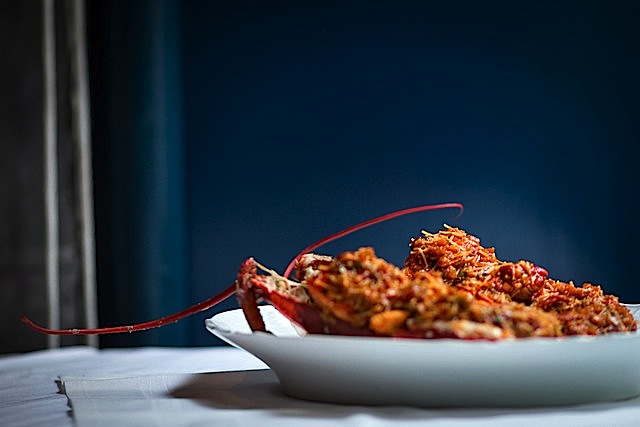 And if I
wanted first-rate Italian-American
fare—which has never stopped evolving ever since
the first Italian immigrants passed through Ellis
Island after 1880—I’ll order the nonpareil fried
zucchini and stewed tripe alla
napoletana at Patsy’s on West 56th
Street at $28; or the linguine with baby
clams for $19.75 at La Masseria
on West 48th Street; or
the veal parmigiana at Mario’s
in the Bronx, for $17.95. Not all the prices at
Carbone are so outrageous—you can get octopus pizzaiolo for
$17 and pork chops with peppers for $27—and
portions are generous. But it’s tough to swallow
Carbone’s hot and cold antipasti at $48 per
person, $45 zuppa
di pesce and the $52 veal Marsala when no
one else in New York dares charge such prices. And
you’re not getting a view of the Hudson or Central
Park or Times Square or the Manhattan skyline from
the Brooklyn side.
And if I
wanted first-rate Italian-American
fare—which has never stopped evolving ever since
the first Italian immigrants passed through Ellis
Island after 1880—I’ll order the nonpareil fried
zucchini and stewed tripe alla
napoletana at Patsy’s on West 56th
Street at $28; or the linguine with baby
clams for $19.75 at La Masseria
on West 48th Street; or
the veal parmigiana at Mario’s
in the Bronx, for $17.95. Not all the prices at
Carbone are so outrageous—you can get octopus pizzaiolo for
$17 and pork chops with peppers for $27—and
portions are generous. But it’s tough to swallow
Carbone’s hot and cold antipasti at $48 per
person, $45 zuppa
di pesce and the $52 veal Marsala when no
one else in New York dares charge such prices. And
you’re not getting a view of the Hudson or Central
Park or Times Square or the Manhattan skyline from
the Brooklyn side.
So, go figure. Carbone
is the restaurant of the moment so it can charge
whatever it likes to people who will pay anything
to be there right this moment, but to call it a
place that redeems, improves upon, and sublimates
Italian-American food to a level it has never
before achieved is simply not the case. Torrisi
and Carbone’s hearts are in the right place and
they produce delicious food. But the irony is that
its current clientele is composed mostly of people
who would never think of eating in
Italian-American restaurants in Little Italy,
Arthur Avenue, or Bensonhurst. And few
Italian families are going to take the kids,
grandma or Aunt Teresa to any place that charges
$50 for veal parm.
❖❖❖
Spanish Wines Offering More Variety and Value
by John Mariani
After the boom years of 2000-2005 when Spanish wine exports soared, sales have cooled off. By why should Spain be any different? Despite the entrance of China into the wine buying market, global wines sales are soft pretty much everywhere.
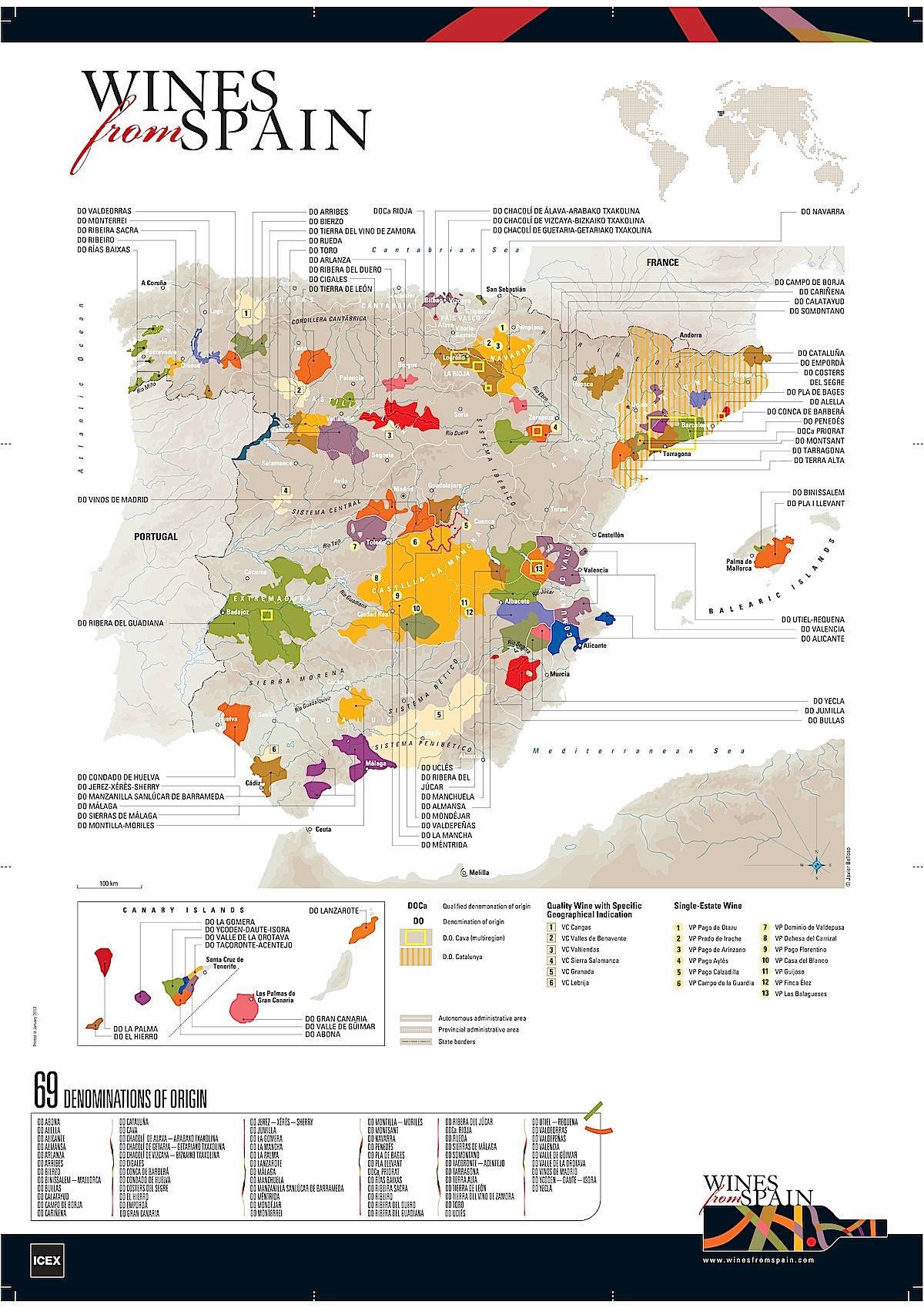
 The International
Organisation of Wine and Vine estimated global
consumption in 2011 to be 1.7 million hectoliters,
with a decrease among several EU nations, including
Spain itself. Germany, the UK, and the U.S. are
still Spanish wines’ biggest customers, and
producers are finding that better quality and
sensible prices are key to an increasingly
sophisticated wine drinker now becoming familiar
with varietals like tempranillo, garnacha and verdejo
from regions like Galicia, Valencia, Catalonia and Aragon.
The International
Organisation of Wine and Vine estimated global
consumption in 2011 to be 1.7 million hectoliters,
with a decrease among several EU nations, including
Spain itself. Germany, the UK, and the U.S. are
still Spanish wines’ biggest customers, and
producers are finding that better quality and
sensible prices are key to an increasingly
sophisticated wine drinker now becoming familiar
with varietals like tempranillo, garnacha and verdejo
from regions like Galicia, Valencia, Catalonia and Aragon.Spain’s cavas (above) are doing very well along with Italy’s proseccos in the sparkling wine market, and the popularity of tapas bars outside of Spain has led to a new interest in the fizzy, low alcohol Basque wine called txakoli. Still, Spanish white wines overall have yet failed to achieve critical parity with the country’s reds.
At the new Spanish brasserie Manzanilla (below, right) in New York, a rosé txacoli is poured by the glass. “A good chunk of our guests tell me they know little or nothing about Spanish wine,” says the restaurant’s wine director, Rick Pitcher, who stocks about 125 Spanish wines. “I then generally point them to lighter wines with high acid that are more versatile with our food, because there is so much sharing of dishes comprised of seafood and meats. For the reds I favor the wines from cooler climates like Galicia.”
Aside from the variety and reasonable prices for Spanish wines, I’ve found that you can readily find an array of older vintages that give perspective to how well these wines age. Twenty years ago, when so many Spanish wines were blends of various vintages, that was not a topic for discussion.
Here are several Spanish red wines I’ve been enjoying recently and plan to drink through spring and summer.
Luis Cañas
Crianza 2008 ($15)—A crianza from Rioja
is a red wine that must spend at least 12 months
in oak and not be sold until its third year, which
allows for mellowing before release. Five percent
garnacha added to 95 percent tempranillo with a
spark of bright fruit helps balance the tannins,
while the acids that make this Rioja Alavesa wine
wholly pleasurable to drink with anything on the
grill this summer. The Canas family has made wine
for generation but has only been selling it since
1970, and they have been pioneers of modern
Spanish viticulture ever since.
Viñedos Valderiz Ribera del Duero
($34)—Bodegas y Valderiz’s Esteban family prides
itself on its commitment to ecological and
biodynamics processes. Their Juegabolos vineyard,
said to have a complex soil structure with a
limestone bottom, gives their Barricas Seleccionad
2006 estate wine a rich minerality, made from 100
percent tempranillo (also called tinto fino).
Today you can easily find it for $34, where just a
couple of years ago it hit $75 a bottle. For
something bolder, though with a little less
finesse, the 2004 Valderiz Ribera del Duero is a
real delight, so good with pork and beef, and a
good 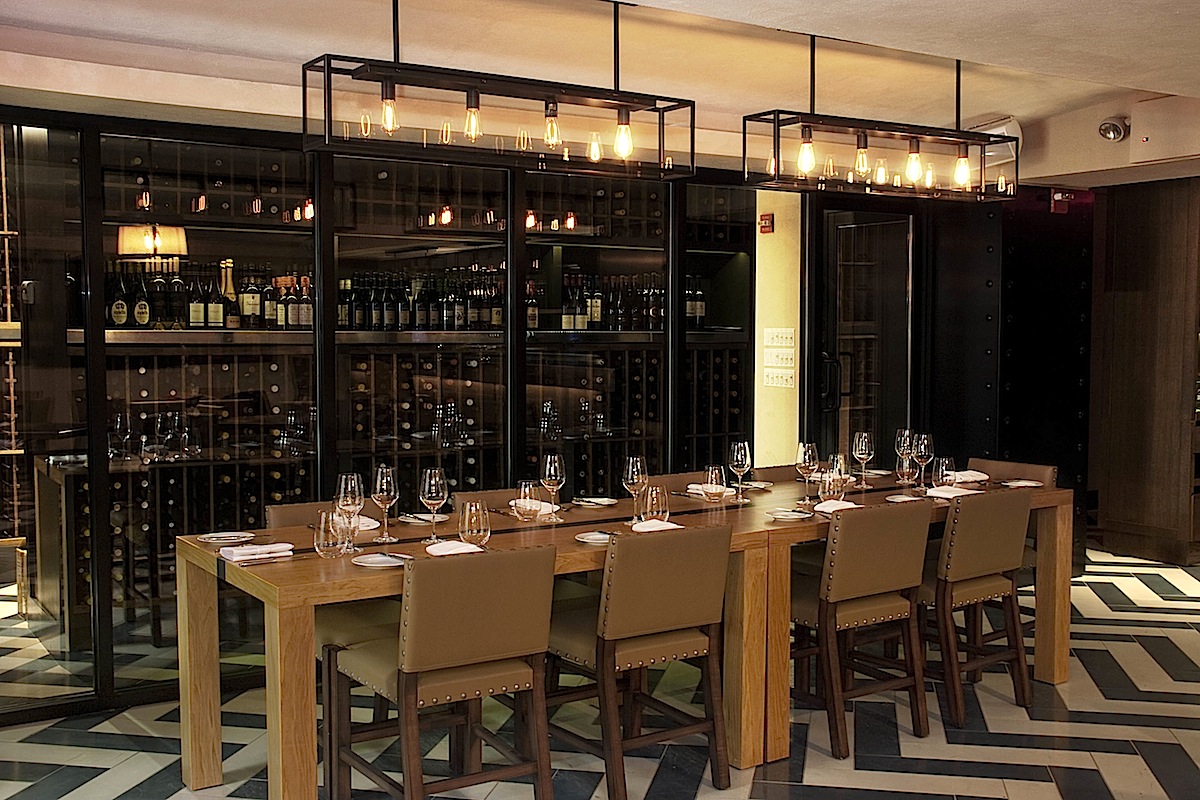 buy for so
well-balanced a red wine of this age.
buy for so
well-balanced a red wine of this age.
Bodegas J.C. Conde Vivir Vinos de Fabula
Vivir 2007 ($14)—On first sip, this
Ribera del Duero from 100 percent tempranillo
doesn’t reveal much and the acids are weak, but
for $14 and at 14 percent alcohol, it is the kind
of wine you stick in a picnic basket with a loaf
of country bread and enjoy with cold chicken and
cole slaw. The vines date back as much as 60 years
in the Burgos District, and the wine is aged 10
months in tanks.
Alta Banderas A10 Crianza 2008
($16)—This wine reveals many layers of dark cherry
and toasted caramel notes, having spent more than
16 months in 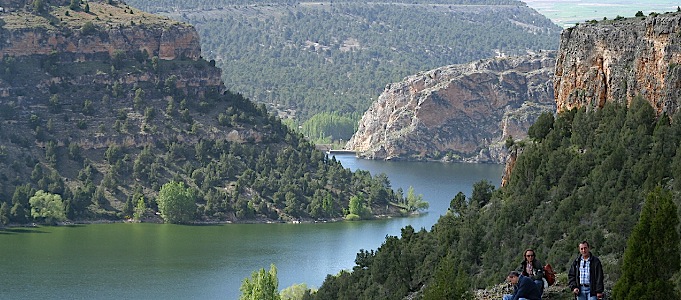 French and
American oak. At 14 percent alcohol it is rich
without being in any way cloying.
French and
American oak. At 14 percent alcohol it is rich
without being in any way cloying.
Dominio de Atauta 2008 ($34)—This
tempranillo is not filtered, which explains the
dark color, rustic style and excellent acidity to
cut through the durable tannins, for which the
tempranillo grape is justly admired. There is a
great deal of ripe berries in it, but the surprise
was that there was, after only four years, a lot
of sediment in the bottle. It needs decanting.
The Duero River of Northern Spain
Xavier Flouret Pavo Real Crianza 2005 ($20)—Winemaker
Nuria Pena Albillo has given this winery from the
1920s a boost in reputation, but you’ll have to be
patient. I found the 2005 still very tannic and
not yet giving up its mellow fruit. The
label says it should be drunk “now and up to ten
years,” and I’d agree with the latter date for
this wine to mature. Its high alcohol, 14.5
percent, is of a style a lot of young Spanish
winemakers are going for to compete with the big
reds of California and South America.
❖❖❖
 NEVER SEEMS TO BOTHER LINDSAY
LOHAN
NEVER SEEMS TO BOTHER LINDSAY
LOHAN
Wolfgang Puck told Eater DC that he once served Jack Nicholson,
who asked, "'You know, Wolf, can I eat in the
kitchen?' I say, 'Why would you want to eat in the
kitchen?' He says, 'I don't like eating outside
because people take pictures with me with my mouth
eating or having a funny face eating something. It's not good
for an actor to get pictures like that.'
"
AND AFTER ALL THOSE PAY-OFFS TO THE POLICE,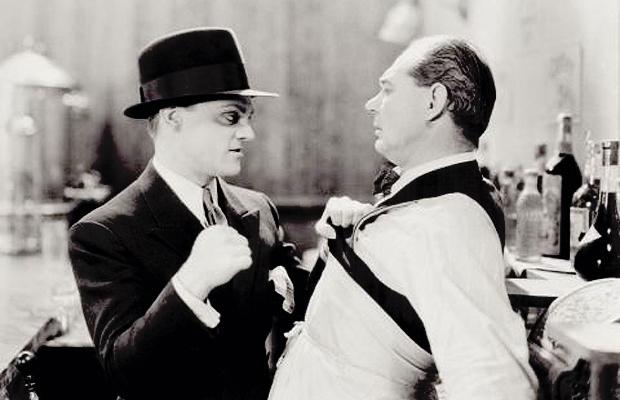
THIS IS WHAT HAPPENS?
Mexican Federal Attorney General
Humberto Benitez Trevino issued an apology for
"the inappropriate behavior of [his] daughter
Andrea" after she threw a temper tantrum at Maximo
Bistro in Mexico City when asked to wait for her
table, without a reservation. The woman then
called city officials and, within hours,
official inspectors came to the restaurant and
posted "suspended" signs. Benitez Trevino added,
"Immediately upon hearing of the situation, I
ordered the raid suspended, to avoid any
excesses."
❖❖❖
Any of John Mariani's
books below may be ordered from amazon.com.
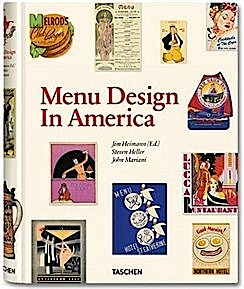 |
My latest book, which just won the prize for best book from International Gourmand, written with Jim Heimann and Steven Heller, Menu Design in America, 1850-1985 (Taschen Books), has just appeared, with nearly 1,000 beautiful, historic, hilarious, sometimes shocking menus dating back to before the Civil War and going through the Gilded Age, the Jazz Age, the Depression, the nightclub era of the 1930s and 1940s, the Space Age era, and the age when menus were a form of advertising in innovative explosions of color and modern design. The book is a chronicle of changing tastes and mores and says as much about America as about its food and drink.
“Luxuriating vicariously in the pleasures of this book. . . you can’t help but become hungry. . .for the food of course, but also for something more: the bygone days of our country’s splendidly rich and complex past. Epicureans of both good food and artful design will do well to make it their coffee table’s main course.”—Chip Kidd, Wall Street Journal.
“[The menus] reflect the amazing craftsmanship that many restaurants applied to their bills of fare, and suggest that today’s restaurateurs could learn a lot from their predecessors.”—Rebecca Marx, The Village Voice. |
"Eating Italian will never be the same after reading John Mariani's entertaining and savory gastronomical history of the cuisine of Italy and how it won over appetites worldwide. . . . This book is such a tasteful narrative that it will literally make you hungry for Italian food and arouse your appetite for gastronomical history."--Don Oldenburg, USA Today. "Italian
restaurants--some good, some glitzy--far
outnumber their French rivals. Many of
these establishments are zestfully described
in How Italian Food Conquered the World, an
entertaining and fact-filled chronicle by
food-and-wine correspondent John F.
Mariani."--Aram Bakshian Jr., Wall Street
Journal.
"Equal parts
history, sociology, gastronomy, and just
plain fun, How Italian Food Conquered the
World tells the captivating and delicious
story of the (let's face it) everybody's
favorite cuisine with clarity, verve and
more than one surprise."--Colman Andrews,
editorial director of The Daily
Meal.com. "A fantastic and fascinating
read, covering everything from the influence
of Venice's spice trade to the impact of
Italian immigrants in America and the
evolution of alta cucina. This book will
serve as a terrific resource to anyone
interested in the real story of Italian
food."--Mary Ann Esposito, host of PBS-TV's
Ciao
Italia. "John Mariani has written the
definitive history of how Italians won their
way into our hearts, minds, and
stomachs. It's a story of pleasure over
pomp and taste over technique."--Danny Meyer,
owner of NYC restaurants Union Square Cafe,
Gotham Bar & Grill, The Modern, and
Maialino.
|
 |
 |
 |
 |
 |
 |
 |
 |
 Everett Potter's Travel Report:
Everett Potter's Travel Report: 
 Eating Las Vegas
is the new on-line site for Virtual Gourmet
contributor John A. Curtas., who since 1995
has been commenting on the Las Vegas food
scene and reviewing restaurants for Nevada
Public Radio. He is also the
restaurant critic for KLAS TV, Channel 8 in
Las Vegas, and his past reviews can be
accessed at KNPR.org.
Click on the logo below to go directly to
his site.
Eating Las Vegas
is the new on-line site for Virtual Gourmet
contributor John A. Curtas., who since 1995
has been commenting on the Las Vegas food
scene and reviewing restaurants for Nevada
Public Radio. He is also the
restaurant critic for KLAS TV, Channel 8 in
Las Vegas, and his past reviews can be
accessed at KNPR.org.
Click on the logo below to go directly to
his site.

Tennis Resorts Online: A Critical Guide to the World's Best Tennis Resorts and Tennis Camps, published by ROGER COX, who has spent more than two decades writing about tennis travel, including a 17-year stretch for Tennis magazine. He has also written for Arthur Frommer's Budget Travel, New York Magazine, Travel & Leisure, Esquire, Money, USTA Magazine, Men's Journal, and The Robb Report. He has authored two books-The World's Best Tennis Vacations (Stephen Greene Press/Viking Penguin, 1990) and The Best Places to Stay in the Rockies (Houghton Mifflin, 1992 & 1994), and the Melbourne (Australia) chapter to the Wall Street Journal Business Guide to Cities of the Pacific Rim (Fodor's Travel Guides, 1991).


MARIANI'S VIRTUAL GOURMET
NEWSLETTER is published weekly. Editor/Publisher: John
Mariani.
Contributing Writers: Christopher Mariani, Robert Mariani,
John A. Curtas, Edward Brivio, Mort Hochstein,
Suzanne Wright, and Brian Freedman. Contributing
Photographers: Galina Stepanoff-Dargery,
Bobby Pirillo. Technical Advisor: Gerry McLoughlin.
© copyright John Mariani 2013
